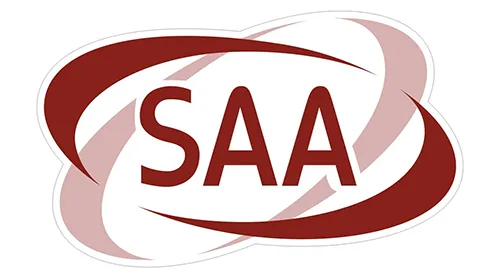
What is the SAA Certification Mark?
Australian saa certification
The SAA certification mark is a safety certification for electrical and electronic products in Australia. SAA stands for Standards Australia International Limited, the national standards body of Australia. Its primary purpose is to ensure the safe use of electrical and electronic products in the Australian market.
The SAA mark has two main types:
1. Type Approval: This applies only to samples, ensuring they meet standards.
2. Standard Mark: This requires a factory inspection for every product.

SAA Certification Process
1. Application Submission
Manufacturers or suppliers submit an application to a certification body, including detailed product information and technical documentation.
2. Product Testing
The product undergoes testing in an accREDited laboratory to confirm compliance with relevant safety standards.
3. Evaluation Report
The laboratory issues an evaluation report certifying that the product meets the standards.
4. Certificate Issuance
If the product passes testing and evaluation, the certification body issues an SAA certification.
Notes:
- Certification validity: 5 years.
- Processing time: 3–6 weeks.
SAA Certification Scope
The SAA certification primarily applies to the following types of devices:
1. Household Appliances:
E.g., washing machines, refrigerators, MICrowaves.
2. Lighting Equipment:
E.g., various lamps, LED lights.
3. Industrial Equipment:
E.g., power tools, machinery.
4. Electronic Devices:
E.g., computers, TVs, audio equipment.
Mandatory Certification List for Electrical Products in Australia and New Zealand
1. Electrical connectors
2. Arc welding machines
3. Bayonet lamp holders
4. Bayonet lamp adapters
5. Carpets
6. Toasters
7. Clothes dryers
8. Control devices
9. Portable cooking utensils
10. Extension cords
11. Switches
12. Decorative lighting
13. Dishwashers
14. Screw lamp holders
15. Electric fans
16. Circuit boosters
17. Heating blankets
18. Floor polishers/cleaners
19. Fluorescent ballasts
20. Fluorescent starters
21. Hair care devices
22. Hedge trimmers
23. Immersion heaters
24. Pest control devices
25. Portable lamps
26. Electric irons
27. Kitchen appliances
28. Lawn care devices
29. Liquid heating devices
30. Movable lamps
31. Spotlights
32. Massage equipment
33. Microwave ovens
34. Miniature circuit breakers
35. Plugs
36. Sockets
37. Power chargers
38. LED modULes
39. Projectors
40. Stoves
41. Range hoods
42. Razors/hair clippers
43. Refrigerators/freezers
44. Residual current devices
45. Room heaters
46. Sewing machines
47. Electric soldering irons
48. Power cords
49. Pool/spa equipment
50. TV receivers
51. Treatment lamps
52. Electric drills
53. Sanders/polishers
54. Circular saws
55. Planers
56. Grinders
57. Chainsaws
58. Vacuum cleaners
59. Wall switches
60. Washing machines
61. Waterbed heaters
62. Water heaters
Certification Bodies
Here are some of the recognized certification bodies for SAA approval:
- Intertek Testing Services (Shenzhen, Guangzhou, Hong Kong, Shanghai FTZ)
- Nemko Shanghai Ltd., Shenzhen Branch
- TÜV SÜD Certification and Testing (China and Hong Kong branches)
- Shenzhen Timeway Testing Laboratories
- Shenzhen Alpha Product Testing Co., Ltd.
- Kiwa Gastec (China) Ltd.
- Bureau Veritas (Shenzhen, Dongguan, Taoyuan branches)
- China Quality Certification Center (South China Lab)
Note: This list is sourced from the SAA official website.
Additional Information
- Voltage Requirements:
- Australia: 240VAC, 50Hz
- New Zealand: AC 230V, 50Hz
- Certification Type: Mandatory + Voluntary
- Certificate Validity: Up to 5 years
- Factory Inspection Requirements: None
- Local Representative Requirement: A locally registered company or agent is required as the certificate holder.
Required Documentation for SAA Application
1. Application form
2. cb certificate and report
3. Product label (including relevant certification marks)
4. PCB layout
5. Circuit diagram
6. User manual (in English or a certified local language)
7. Plug test report (for Australian plugs).
Email:hello@jjrlab.com
Write your message here and send it to us
 WEEE Registration for Waste Electrical &Electr
WEEE Registration for Waste Electrical &Electr
 MSDS Chemical Safety Testing
MSDS Chemical Safety Testing
 What Are the Differences Between UK REACH and EU R
What Are the Differences Between UK REACH and EU R
 E-Cigarette GB 41700 Compliance Testing
E-Cigarette GB 41700 Compliance Testing
 What Are the Testing Items of California Propositi
What Are the Testing Items of California Propositi
 E-Cigarette EU TPD Testing
E-Cigarette EU TPD Testing
 Testing Certification for E-cigarettes Exported to
Testing Certification for E-cigarettes Exported to
 What is Amazon US CPC Certification?
What is Amazon US CPC Certification?
Leave us a message
24-hour online customer service at any time to respond, so that you worry!




